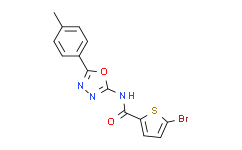| 中文名称: | KKL-10 | ||||
|---|---|---|---|---|---|
| 英文名称: | KKL-10 | ||||
| 别名: | KKL-10;KKL10 | ||||
| CAS No: | 952849-76-2 | 分子式: | C14H10BrN3O2S | 分子量: | 364.22 |
| CAS No: | 952849-76-2 | ||||
| 分子式: | C14H10BrN3O2S | ||||
| 分子量: | 364.22 | ||||
基本信息
|
产品编号:K10073 |
|||||
|
产品名称:KKL-10 |
|||||
|
CAS: |
952849-76-2 |
储存条件 |
粉末 |
-20℃ |
四年 |
|
|
|
||||
|
分子式: |
溶于液体 |
-80℃ |
两年 |
||
|
分子量 |
364.22 |
-20℃ |
一个月 |
||
|
化学名: |
5-bromo-N-(5-(p-tolyl)-1,3,4-oxadiazol-2-yl)thiophene-2-carboxamide |
||||
|
Solubility (25°C) |
体外 |
DMSO |
3mg/mL (8.23mM) |
||
|
Ethanol |
Insoluble |
||||
|
Water |
Insoluble |
||||
|
体内 |
现配现用 |
|
|||
|
<1mg/ml表示微溶或不溶。 |
|||||
|
普西唐提供的所有化合物浓度为内部测试所得,实际溶液度可能与公布值有所偏差,属于正常的批间细微差异现象。 |
|||||
|
请根据产品在不同溶剂中的溶解度选择合适的溶剂配制储备液;⼀旦配成溶液,请分装保存,避免反复冻融造成的产品失效。 |
|||||
制备储备液
|
浓度
溶液体积 质量 |
1mg |
5mg |
10mg |
|
1mM |
2.7456mL |
13.7280mL |
27.4559mL |
|
5mM |
0.5491mL |
2.7456mL |
5.4912mL |
生物活性
|
产品描述 |
一种具有广谱抗菌活性的小分子核糖体拯救抑制剂。 |
|
靶点/IC50 |
ribosome rescue |
|
体外研究 |
The ribosome rescue inhibitor KKL-10 exhibits exceptional antimicrobial activity against both attenuated and fully virulent strains of F. tularensis. The minimum inhibitory concentration (MIC) against F. tularensis strain LVS and Schu S4 are 0.12 and 0.48μg/mL, respectively. KKL-10 arrests intracellular growth of F. tularensis during all stages of infection. KKL-10 does not affect macrophage viability or function. KKL-10 produces cytotoxic effects of less than 5% at concentrations up to 17.5μg/mL. The combination of IFN-γ stimulation and KKL-10 activity results in a reduction of the bacterial load by >99.9%. KKL-10 is also able to inhibit growth of F. tularensis inside eukaryotic cells and show no toxicity to HepG2 cells. |
本计算器可帮助您计算出特定溶液中溶质的质量、溶液浓度和体积之间的关系,公式为:
质量 (g) = 浓度 (mol/L) x 体积 (L) x 分子量 (g/mol)
摩尔浓度计算公式
用本工具协助配置特定浓度的溶液,使用的计算公式为:
开始浓度 x 开始体积 = 最终浓度 x 最终体积
稀释公式
稀释公式一般简略地表示为:C1V1 = C2V2 ( 输入 输出 )








